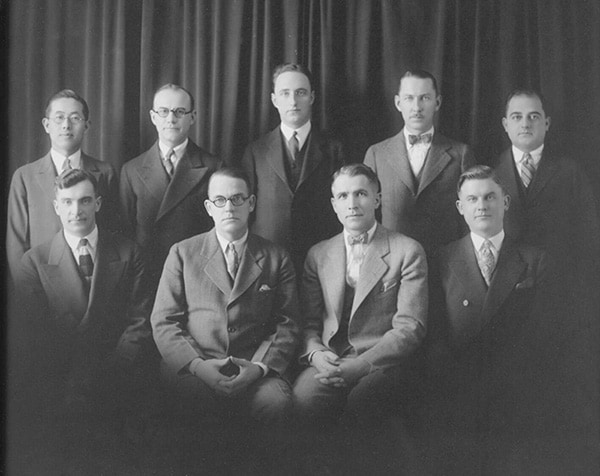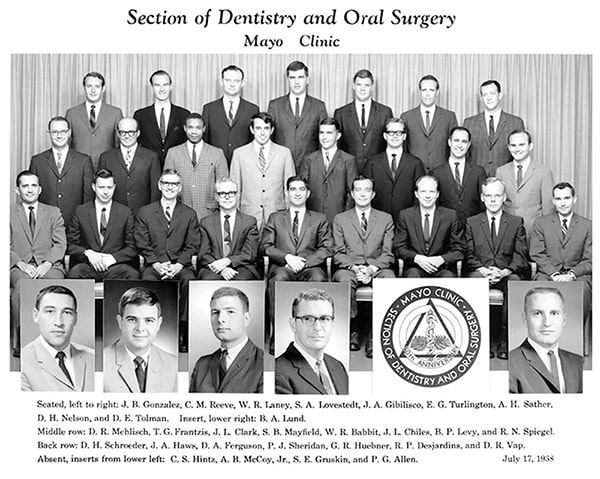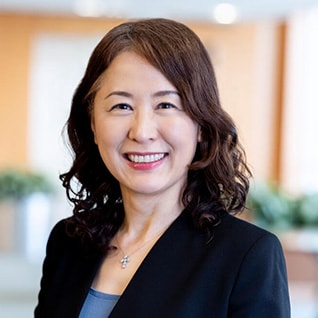Department and Faculty
/prod01/channel_2/media/mccms/content-assets/academics/residencies-and-fellowships/orthodontics-residency-minnesota/orthodontics-residency-mn-1024X683-WF3431900-0172.jpg)
The Department of Dental Specialties staff at Mayo Clinic in Minnesota provides coordinated care for patients who require specialized dental treatment.
History of the Department of Dental Specialties
 The department is created
The department is created
With more than 100 years of dental specialty care within a medical institution, the history of the department of dental specialties at Mayo Clinic shaped the department it is today.
On October 1st, 1918, Dr. Boyd Gardner (pictured in the front row, center left), formed the section of Dental Surgery at Mayo Clinic.
“We early staff members were most fortunate to have had the privilege of associating with Drs. Will and Charlie for so many years…I am convinced the determination of the brothers Mayo that any physician should be welcome to learn from them was a major factor in the success of the Clinic.”
 Dental programs are formed
Dental programs are formed
Beginning in 1918, special students in dental surgery were admitted to the Mayo Graduate School of Medicine. In 1935, advanced programs in oral surgery became available through the Mayo Graduate School.
By 1966, three additional dental residencies had formed: Orthodontics, Periodontics, and Prosthodontics.
The Prosthodontics residency previously included the Maxillofacial Prosthetics and Dental Oncology fellowship, which became its own program in 2016.
From the program director
 Thanks for your interest in Mayo Clinic's Orthodontics and Dentofacial Orthopedics Residency. Our comprehensive 36-month program offers a profound clinical experience as well as an opportunity to earn a master’s degree in biomedical science from Mayo Clinic Graduate School of Biomedical Sciences, coupled with a certificate in Orthodontics from Mayo Clinic School of Graduate Medical Education.
Thanks for your interest in Mayo Clinic's Orthodontics and Dentofacial Orthopedics Residency. Our comprehensive 36-month program offers a profound clinical experience as well as an opportunity to earn a master’s degree in biomedical science from Mayo Clinic Graduate School of Biomedical Sciences, coupled with a certificate in Orthodontics from Mayo Clinic School of Graduate Medical Education.
Admission to our program is competitive, with only one resident accepted annually. Applications are processed through ADEA's Postdoctoral Application Support Service (PASS), and resident selection is made through the National Matching Services dental program (Dental Match). Residents earn stipends from PGY-1 to PGY-3 while in training, and there are no tuition fees.
The orthodontic training we provide is unique in academic dentistry. Our residents serve as fully practicing clinicians within our fully staffed outpatient practice, and clinical care comprises most of the training. Each first-year resident will begin treatment on approximately 120 patients and will follow their care throughout training.
In your three years of training, we anticipate you will be involved in the development of 400-500 patient care treatment plans. Many of our patients are seen in support of our colleagues in the medical practice or with other dental specialists, whose treatment includes patients with cleft and craniofacial syndromes, facial trauma, temporomandibular joint replacement, orthognathic surgery, OSA and sleep-disordered breathing, head and neck cancer, and complex dental reconstructions. Additionally, you will also get extensive experience with routine orthodontic care.
To gain a deeper understanding of our educational philosophy, we encourage you to review our educational mission statement. We extend our best wishes as you contemplate Mayo Clinic as your future training home.
Ji Hyun Ahn, D.D.S.
Program Director, Orthodontics Residency
Faculty
In addition to caring for patients in their clinical practices, Mayo Clinic's faculty members are committed to teaching and facilitating the growth of medical knowledge. Many of our faculty have published and lectured extensively and are highly regarded in their field. You will have direct access to these individuals throughout your training program.
Advisers and mentors
You will choose a mentor to serve as your advocate in academic, clinical and personal arenas. Academic progress is monitored and residents with academic/staff potential are identified early and, if interested, are mentored in pursuing an academic career.
Visiting professors
Many prominent professors visit Mayo Clinic each year. They present their work during morning and late afternoon lectures. Residents are encouraged to take full advantage of these opportunities to interact with experts from other academic centers and are relieved from clinical assignments to do so.